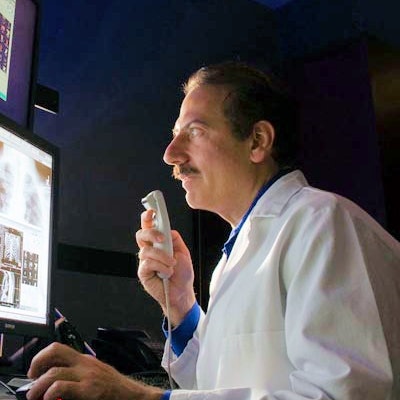
Artificial intelligence (AI) can help radiology reinvent itself in a post-COVID world, helping the specialty navigate challenges such as social distancing, extreme imaging volume variability, and radiologist burnout, according to a talk at AuntMinnie.com's Fall 2020 Virtual Conference (AMVC).
 Dr. Eliot Siegel of the University of Maryland.
Dr. Eliot Siegel of the University of Maryland."The COVID-19 pandemic has not only created new challenges for diagnostic imaging but has exacerbated some of our existing ones such as fatigue, stress, and burnout," said Dr. Eliot Siegel of the University of Maryland School of Medicine. "While the pandemic has accelerated the development of AI algorithms, AI and imaging informatics in general are going to continue to accelerate the transformation of radiology to make it more efficient, accurate, and safe for patient care and will bring radiology into the era of personalized precision medicine."
The pandemic is going to have a major and lasting impact on the practice of diagnostic imaging, more than anything else has in the last 50 years, Siegel said. He suggested that impacts will be felt in three fundamentally important areas:
- The need for social distancing, which has resulted in a major acceleration of the trend toward remote practice, including remote image interpretation, scheduling, administration, and even image acquisition of imaging procedures. Patients have also been reluctant to undergo diagnostic and interventional imaging procedures.
- The potential for rapid variability in imaging volume, down to as low as 30%-40% for both inpatient and outpatient imaging. A gradual recovery has occurred, but most practices are not back yet to 100% of their normal volume, and there's uncertainty about the future, Siegel added. This dynamic creates a fundamental change in perception by practices and radiologists of vulnerability to major shifts in staffing, billing, and job security.
- Stress, burnout, psychic trauma, and economic injury for imaging personnel.
Social distancing
For radiologists, distancing has largely translated into remote reading. The pandemic has loosened up many of the restrictions that radiologists may have previously had as far as being able to take workstations and monitors home and perform primary interpretation, Siegel said.
"Interestingly, a lot of the early AI providers offered their solutions to algorithms for stroke, intracranial hemorrhage, lung nodules, breast cancer, cardiac MRI, etc. over the cloud," Siegel noted. "And it's become a little easier to consume things over the cloud during the pandemic period, when some of these restrictions have been at least slightly relaxed anyway."
Now that radiologists are home, they need to be able to seamlessly, and as part of their workflow, access information from the electronic medical record (EMR). This has created a requirement to have that information available in the PACS, Siegel said. Another interesting development has been the potential to remotely perform diagnostic, as well as interventional procedures for radiologists and, to some extent, technologists as well, he added.
Rethinking PACS
The pandemic may also result in rethinking of some of the fundamental concepts around PACS itself.
"Remote image interpretation will make intelligent workflow orchestration more important than ever," Siegel said. "As we're reading from home, the ability for vendors to be able to send the right images to the right radiologist at the right time is more important than ever."
The pandemic may also accelerate the evolution or devolution of PACS into a more AI-centric combination of separate visualization, analytics, decisions support, and reporting modules, according to Siegel.
"So the days of PACS itself may be numbered, and get replaced by best-of-breed AI applications that may replace PACS fundamentally," Siegel said.
Radiology information systems and PACS could actually even migrate to an architecture that emulates smartphones and is driven by a single AI workflow orchestrator that interfaces with modules for the electronic health record, archive, scheduling program, and different AI applications such as viewers, AI quantification and decision support, diagnosis, and reporting, etc. he said. This transition could be accelerated by the challenges associated with the pandemic.
Remote interventional radiology
In addition to diagnostic radiology, remote interventional radiology has potential for cardiologists, radiologists, and technologists using advanced robotics.
"There's the potential for artificial intelligence to play a significant role in pre-interventional planning, and to be able to do real-time, cross-sectional registration of CT and MRI images associated with real-time fluoroscopy," Siegel said.
AI can also help to decrease patient no-show rates, a major issue that affected radiology departments even before the pandemic and has gotten even more challenging since.
"Having a machine-learning program that can continue to learn and adapt with changes associated with the ebbing and flowing would be extraordinarily helpful," he said.
"I think AI can play a really major role here in reducing no-show rates and having departments be able to be prepared for patient no-shows."
Screening may need to be reinvented to some extent as well. When patients are told that their liquid biopsy results are suspicious or put them at high risk for certain cancer types, that puts further pressure on screening, Siegel said.
"The other thing is that screening may need to get smarter by more precisely identifying populations at risk for certain diseases," he noted. "What we really want to do is be able to decrease the number of patients required for screening, but screen them more intelligently so that we have higher yields."
Dealing with unpredictability
The incredible variability and unpredictability of imaging volume during this period has been unique in the history of radiology, Siegel stated. There's potential, however, to use AI to achieve increased efficiency in areas such as automated reading, preliminary interpretation, streamlining of reporting, and being able to assess relative "elasticity" in the coverage of radiologists. This could enable practices to determine how they could expand or contract coverage in an environment where imaging volumes decrease dramatically, Siegel said.
There's also an opportunity for AI to enhance scanning efficiency, potentially decreasing waiting and imaging times for patients, he said.
Siegel noted that a tremendous amount of AI literature has been devoted to improving image interpretation, including interpretation of lung nodules, pediatric bone age estimation, and detecting intracranial hemorrhage or fracture detection, etc. Many AI algorithms also focus on quantitative imaging or radiomics applications.
"I think there are also going to be an increasing number, which we don't have much of now, of algorithms that focus on enhanced efficiency and productivity, in addition to just enhanced accuracy and decision support," he said.
Augmented, not replaced
Siegel agrees with other radiology luminaries that radiologists will be augmented by AI, not replaced by it. AI algorithms have gotten really good at narrow tasks such as determining pediatric bone age, finding fractures, or looking for lung nodules and intracranial hemorrhages, he said.
However, "doing something such as interpreting a routine [intensive care unit] chest radiograph is really beyond the ability of the vast majority of AI developers with regard to image interpretation," he added. "Being able to look at trends in disease, correlate clinical information, and be able to discern complex patterns from just an [intensive care unit] chest radiograph is really extraordinarily difficult."
AI can also save radiologist reporting time by generating impressions from the radiologist's body of the report, potentially saving as much as 24% of the radiologist's time spent on CT studies, for example, while reducing their mental workload and risk of burnout, he said.
The technology could also potentially be used to exclude a high percentage of screening mammograms as normal, decreasing the number of screening mammography studies that need to be read by the radiologists.
CMS reimbursement
In early September, the U.S. Centers for Medicare and Medicaid Services (CMS) granted a new technology add-on payment (NTAP) for stroke detection AI software from Viz.ai. The decision was groundbreaking, Siegel said.
"The NTAP for stroke assessment may have created the potential for interesting additional possibilities," he noted. "Certainly, reimbursement may significantly accelerate investment in AI and may accelerate interest in getting these AI applications removed from the theoretical to actual clinical applications."
Some interesting future possibilities for future reimbursement along the lines of this NTAP decision could include providing a "triple rule out" for chest pain in the emergency room, assessment of intraperitoneal blood volume in trauma patients, detection of cervical spine fractures, and even evaluation of chest imaging in COVID-19 patients to make decisions about admission or being placed on a ventilator, etc., Siegel said.
"I think the implications from this decision about saving time in general as a driver for reimbursable AI technologies paves the way to a lot of new possibilities," he concluded.
Part 2 of our coverage of Dr. Eliot Siegel's talk at AuntMinnie.com's Fall 2020 Virtual conference will discuss how AI can help to alleviate radiologist stress and burnout during and after the COVID-19 pandemic.
To access AuntMinnie.com's Fall 2020 Virtual conference, click here. Presentations will be available for on-demand viewing for 30 days after the meeting concludes on 23 September.



















